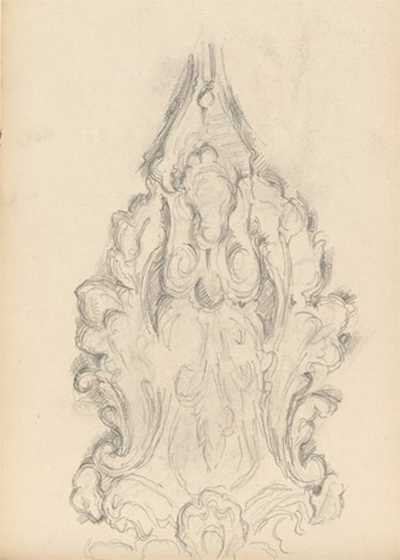 Buy Art Prints Now
Buy Art Prints Nowfrom Amazon
* As an Amazon Associate, and partner with Google Adsense and Ezoic, I earn from qualifying purchases.
Sketching of ornamental items as well as classical sculptures was an important method by which Cezanne practiced and developed his drawing skills. Here he took on something rather complex as a way of showing respect to the original piece as well as learning more about shadows within intricate objects.
The layout of this drawing, where the bottom half is cropped out, almost by accident, suggests that Cezanne did not overly plan this piece and worked pretty quickly. You will not find evidence of amendments up close, such as rubbed out elements or re-angled parts. Instead, he worked in subtle lines before slowly darkening the shaded areas. It appears that he started at the top, leaving room for the piece to breathe, and then working downwards before eventually running out of space. He would have sat patiently whilst working, able to carry around his sketchbook and perhaps a selection of graphite tools. Cezanne is known to have travelled to museums and galleries in order to perfect his drawing skills, though it is not clear where exactly he came across this item.
The sketchbook in which this drawing was found is still in good condition and features around seventy artworks together in a single bound book. Efforts have been made to preserve its quality as well as avoiding the pitfalls that have happened with most of his other sketchbooks, where single pages have been removed and sold seperately. This has led to Cezanne drawings being dispersed widely across the world, making it hard to provide a comprehensive collated list of them, as well as encouraging an increase in fake artworks being linked to his name. Thankfully, efforts have been made in recent times to pull them all together with a number of research projects and these have, in general, being fairly successful in putting together an accurate catalogue of his work across all the mediums in which he was involved.
In all, there were hundreds of drawings left over from this artist's career. Some were studies, such as this one, whilst others were genuine artworks in their own right, such as portraits of his wife and child. Cezanne had a fairly concise use of genres within his career and through his drawings we can discover how he planned and perfected his work in each one. For his scenes of village life, for example, he would pay particular attention to the angles of buildings, where he clearly found perspective to be a significant challenge. In other cases it would be the facial expressions that he wanted to revisit many times over. He would also use sculptures as a means to learning more about the casting of shadows and found this easier than hiring a live model for the same purpose.



